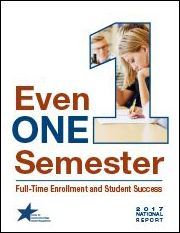
Based at The University of Texas' College of Education, the Center for Community College Student Engagement (CCSSE) focuses on research related to student engagement at community and technical colleges. Their deep commitment to improving educational quality and student success produces research data and reports that can and should inform the work being done by those of us in the ATE community. These include a number of initiatives that focus on qualitative research as well as various national reports, which are disseminated broadly to a wide variety of audiences including educators, education researchers and organizations, and the media.
A good example of the excellent work being done by the Center is a recent report titled Even One Semester: Full-Time Enrollment and Student Success. This report explores data and correlations between levels of attendance, student experiences, and related issues like completion. The report is a pleasure to read and is filled with graphics, quotes, and photos that help contextualize the data and ground the research in the reality of today’s community college environment.
The report encourages readers to consider redefining the various types of attendance and posits that many of us tend to think about students as being either full-time or part-time. Their redefinition expands to include a third type of attendance pattern that, according to their data, is actually the dominant type – this is what they call a “fluid attendance pattern.” From the data they collected, almost 55% of students who have attended college for at least three terms fall into this attendance category. This means that they are full-time for some semesters and part-time for others. According to the report, less than 20% of students are always full-time and about 30% are always part-time.
The benefits of full-time attendance, even for one semester, were surprisingly broad with students gaining access to more support on campus (better orientations, more time to connect with others, better access to faculty) as well as consistently higher levels of engagement and a higher likelihood of completing both important gateway courses as well as ultimately earning credentials.
At a practical level, the report also provides advice for educators and administrators, including the rather simple step of asking each student, “Is there any way you could attend college full-time, even for one semester?” They also encourage conversations around issues related to completion time and work/school/life balance. The report highlights a number of initiatives around the country that have been put in place that encourage full-time attendance, providing salient details and some impact data.
For those in the ATE community the report could prove useful at a number of levels, here are a few ideas that come to mind:
- Use the report data to help support the needs section in a grant proposal
- Use data from the report as a benchmark when looking at your own student‘s attendance patterns
- When considering program improvement, share the report with colleagues, industry partners or others to brainstorm ways to increase full-time attendance
- As applicable, use data or quotes from the report in annual reporting
- Use the report as the basis for professional development trainings – helping faculty and administrators develop strategies for upping full-time attendance

 Subscribe
Subscribe


 See More ATE Impacts
See More ATE Impacts

Comments
There are no comments yet for this entry. Please Log In to post one.